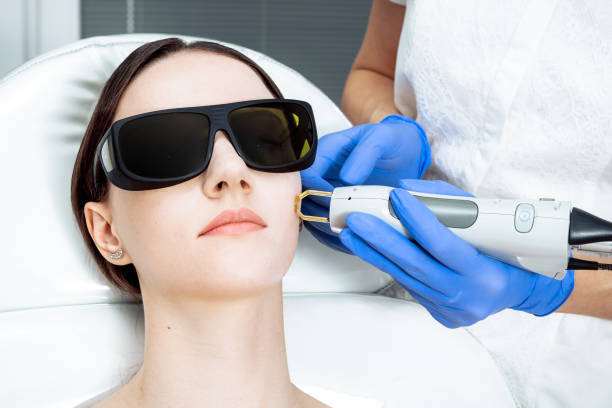Laser pigmentation treatment is a popular method for addressing various skin pigmentation issues, from age spots and freckles to melasma and hyperpigmentation. If you're considering this treatment, proper preparation is crucial for optimal results and minimal side effects. This guide will help you understand what to expect and how to prepare for your laser pigmentation treatment.
Understanding Laser Pigmentation Treatment
Laser pigmentation treatment uses focused beams of light to target and break down pigmented cells in the skin. These treatments are often used to address age spots, sun damage, melasma, and other forms of hyperpigmentation. The laser's precision allows for targeted treatment without affecting surrounding tissues.
Reasons for Laser Pigmentation Treatment
Laser treatment can be an effective solution for various pigmentation issues. It's minimally invasive, with quick recovery times compared to surgical procedures. Whether you're dealing with dark spots from sun exposure or other pigmentation irregularities, laser treatment can offer a path to clearer, more even-toned skin.
Preparing for Your Treatment
Before undergoing laser pigmentation treatment, a consultation with a dermatologist is essential. They will assess your skin type, the nature of your pigmentation issues, and determine the best laser technology for you. This step is critical to ensure the treatment is tailored to your specific needs and to minimize potential risks.
Pre-Treatment Instructions
Your dermatologist will likely provide specific pre-treatment instructions to follow. This typically includes adjustments to your skincare regimen. For example, you might need to stop using certain exfoliants, retinoids, or other products that could sensitize your skin. It's also crucial to avoid excessive sun exposure and tanning beds before your treatment, as they can increase the risk of complications.
Lifestyle Changes Before Treatment
Lifestyle factors can impact the success of your laser pigmentation treatment. Maintaining a healthy diet and staying hydrated can promote skin health and support the healing process. If you smoke or consume alcohol regularly, consider reducing or eliminating these habits before your treatment. Additionally, managing stress through exercise, meditation, or other methods can be beneficial.
Scheduling and Logistics
Choosing the right time for your treatment is crucial. Consider your work schedule, upcoming events, and other commitments. You'll likely need a few days of downtime after the treatment, so plan accordingly. If you have a busy work week or a significant event, it might be best to schedule your treatment during a quieter period.
On the Day of Treatment
On the day of your laser pigmentation treatment, dress comfortably and avoid wearing makeup on the treatment area. Bring any necessary paperwork or identification, and be prepared to discuss any recent changes in your health or medication. The procedure is typically quick, lasting between 15 and 30 minutes, depending on the treatment area.
Post-Treatment Care
After your treatment, you might experience some redness, swelling, and mild discomfort. Your dermatologist will provide post-treatment care instructions, which usually involve applying soothing creams or ointments and avoiding direct sun exposure. It's crucial to follow these instructions closely to ensure proper healing and minimize the risk of complications.
Common Side Effects and How to Handle Them
Common side effects after laser pigmentation treatment include redness, swelling, and discomfort. These symptoms usually subside within a few days. To manage them, apply cold compresses, avoid hot showers, and keep the treatment area clean. If you experience severe pain, blistering, or other unusual symptoms, contact your dermatologist immediately.
Expected Results and Follow-Up
Laser pigmentation treatment results vary depending on the individual and the severity of the pigmentation issue. You might notice some improvement after the first session, but it often takes multiple sessions to achieve the desired results. Follow-up appointments are crucial to monitor your progress and make any necessary adjustments to your treatment plan.
FAQs About Laser Pigmentation Treatment
1. Is laser pigmentation treatment safe for all skin types?
Laser treatment can be safe for most skin types, but some lasers are better suited for certain skin tones. It's important to consult with a dermatologist to ensure the chosen treatment is appropriate for your skin type.
2. How long does a typical session last?
A typical laser pigmentation treatment session lasts between 15 and 30 minutes, depending on the size of the treatment area.
3. What should I avoid before and after treatment?
Before treatment, avoid sun exposure, tanning beds, and certain skincare products. After treatment, follow your dermatologist's instructions regarding sun protection and post-treatment care.
4. When will I see results after laser treatment?
You might see some improvement after the first session, but it often takes multiple sessions to achieve significant results. The full effects of the treatment can take several weeks to become apparent.
5. How many sessions are typically required?
The number of sessions needed varies based on the individual and the severity of the pigmentation issue. Generally, 3-6 sessions are required for optimal results.
Conclusion
Laser pigmentation treatment can be a highly effective solution for addressing various pigmentation issues. Proper preparation is key to ensuring a successful treatment and minimizing potential risks. By following the tips and advice in this guide, you'll be better equipped for your upcoming treatment and set the stage for a smoother recovery.





Comments